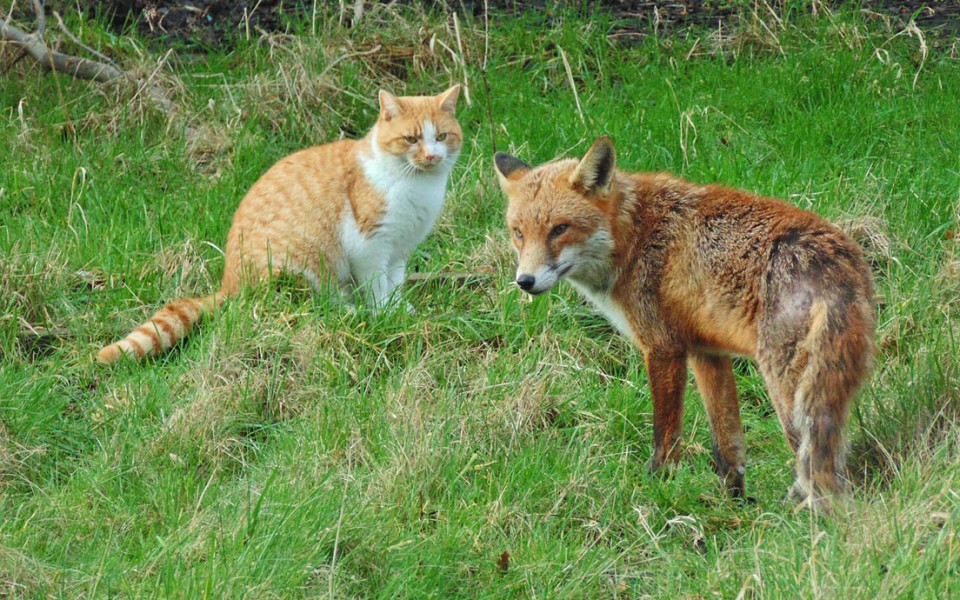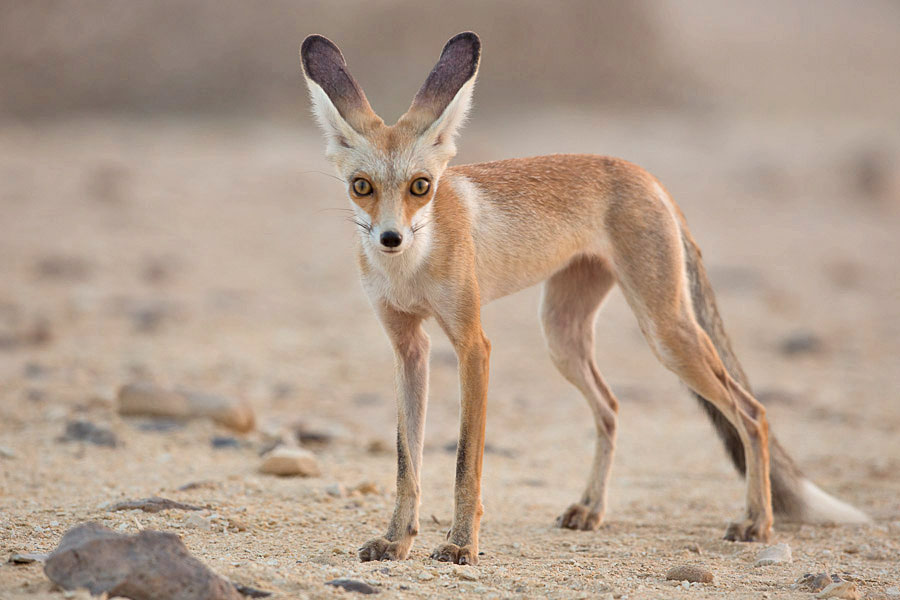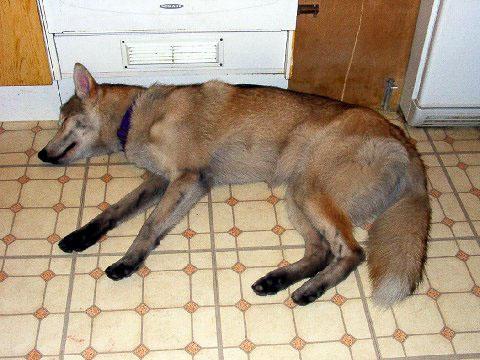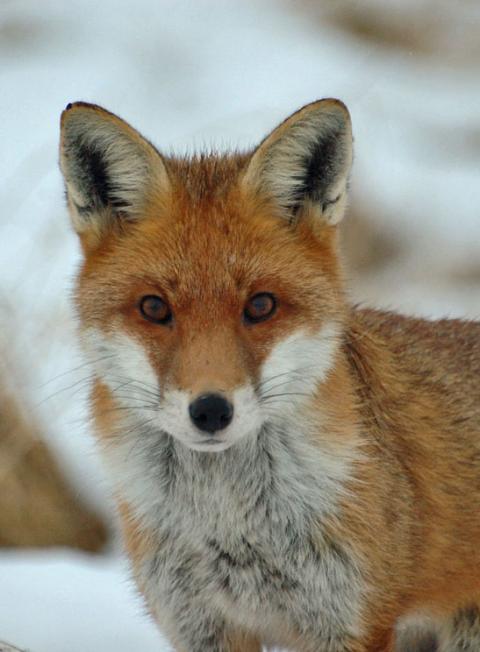Red Fox Size
The Red fox is the largest member of the Vulpes genus and shows enormous variation in size across its range; they’re also deceptively difficult to size at distance, often appearing larger than they really are – most foxes are about the same size as an adult domestic cat. Globally, most individuals have a head and body length (HBL) in the range of 45cm to 90cm (1.5 – 3ft); add an extra 30cm to 50cm for the brush (tail) and foxes can reach a total length of about 150cm (just under 5ft). In the UK, adult male foxes typically range in HBL between 67cm and 72cm (26 - 28in.), while females fall between 62cm and 68cm (2ft – 2ft 4in.).
The tail makes up just over one-third of the total body length and the longest record for a brush I have come across is 55.5cm (almost 2ft.). In his 1950 book, Wild Animals in Britain, Oliver Pike described one “magnificent creature” that measured 64 inches (163cm) from nose-to-tail. In his An Irish Beast Book, James Fairley notes that foxes in Northern Ireland have shorter tails than those in Britain - in Scotland and England, Fairley explains, tails average about 60% of the HBL, while in Ireland the figure is only 50%.

By looking at skull and tooth size measurements, Polish zoologist Elwira Szuma found that the largest Nearctic (North American) foxes were those from Alaska’s Kodiak Island and the Kenai Peninsula, while the smallest lived in California and Georgia; in the Palearctic (Europe and Asia), the largest foxes come from the Far East while the smallest are from the southern borders of the Eurasian range. Within Europe, Szuma found that Scandinavian foxes are the largest, followed by those in Britain.
Foxes are also deceptively light canids; thanks in part to their very slender leg bones, they weigh about 30% less than you’d expect for a dog of their size. In Britain, the average weight of an adult male fox is around 6.5kg (14 lbs), with a typical range of 4kg to 8kg (9 – 17.6 lbs); adult females average 5.5kg (12 lbs), with a typical range of 4kg to 6kg. In North America, foxes typically range from 3.5kg to 7kg (8 – 15.4 lbs), with vixens and dogs averaging 4kg and 5kgs, respectively. Globally, the range of weights for Red foxes is generally given as 3kg to 14kg (31 lbs) although, as we shall see, this should be extended to 16kg (35 lbs).
With the apparent exception of a few local subspecies (schrencki and japonica living in Japan and some populations in Norway, for example), Red fox size follows Bergmann's Rule -- i.e. body size is correlated with latitude -- so foxes in the north of their range tend to be larger than those occupying more southerly areas (sometimes referred to as the ‘north-south cline’), although the effect may be diluted where recent introductions have been made. These geographical differences may also be sex-specific and a study of foxes living in a nature reserve in Pisa, Italy found that females from southern hills were fatter than those from internal valleys which, in turn, were fatter than those from the coastal belt - males, by contrast, showed no obvious differences between these regions/habitats.
It is important to recognise that weight not only varies individually and geographically, it also fluctuates throughout the year and this may also be sex-specific. The same study -- of 330 foxes from the Province of Pisa in Italy between January and May 1992 by Paolo Cavallini -- found that dog foxes lost weight throughout the breeding season and, based on gut contents, larger males fed much less than smaller ones during the peak of the season. Females, by contrast, fed consistently throughout the period and maintained fairly constant body weights.

Weight is often the only measurement given for foxes but, as H. Gwyn Lloyd notes in his 1980 book The Red Fox, it is important to match weight to linear dimensions; then we find that although, for example, Irish foxes appear heavier than English ones, they’re also leaner. Indeed, there is terrific variation in size within the UK’s fox population and this presumably reflects differences in habitat.
In a 1979 paper to the Journal of Zoology, M.A.F.F. biologists L.W. Huson and Robert Page demonstrated that fox skulls from Wales were larger than those from south-east England. In a paper to the same journal during the following year, the same biologists analysed skulls from six Welsh counties and found that those from Pembrokeshire and Carmarthen were similar, but differed significantly to those from Brecon, Cardigan, Radnor and Montgomery. Huson and Page considered that some of the differences between the populations were attributable to variability between upland and lowland habitats.
Many authors have written of the different ‘breeds’ of fox to be found in Britain (see QA for more details). Some authors have considered there to be as many as four, but most have been content simply to divide them into ‘upland’ (variously referred to as Greyhound, Hill, Highland and Mountain foxes) and ‘lowland’ (Terrier, Mastiff, Cur, Little and Common) foxes; upland animals are said to be larger, with longer legs, coarser greyer fur and increased stamina over their smaller, shorter-legged, orangey-red lowland conspecifics. How many, if any, of these breeds are actually distinct remains to be demonstrated, but several studies have shown that Scottish foxes are generally larger than English ones, closely matching Scandinavian foxes in size; some have suggested they’re descendants of stock imported from the continent. The suggestion has also been made that the long winter nights at high latitude could allow the foxes longer to hunt when food is hardest to find and more food could allow them to grow larger.
Another suggestion is that the increasing day length leads to increased primary productivity (plant growth), which could translate to more available fox food. Either way, the larger size implies an adaptation to upland areas, where food is more widely dispersed and less predictable and weather conditions are harsher (larger bodies lose heat less quickly than smaller ones, which helps in cold environments, while longer legs can be a bonus in snow). It should be mentioned at this point that foxes are also susceptible to congenital growth disorders that may affect their body proportions. In late March 2017, for example, South Essex Wildlife Hospital took in a fox approximately one year old with stunted legs. The hospital confirmed:
“It's small in the body and its legs are half the length they should be…”

There are many stories of large foxes having been spotted; the most recent one I have come across was an interesting account of a fox the size of a “large roe deer” that was reported near Tilford in Surrey on 30th April 2011. Unfortunately, there was no photographic or video evidence of the animal and, although the witness watched the animal for several minutes and was convinced it was “absolutely a fox”, such reports remain unconfirmed. Invariably, most reports of very large foxes are cases of mistaken identity – several dog breeds, including long-haired Alsatians and Red Huskies can, under some conditions, look very fox-like. Even dogs that don't have any particularly 'foxy' colour to them can, under certain circumstances, appear very fox-like. The adjacent photo, sent in by Wildlife Online reader Lynn Harrison, is a good example - it shows her husky after it had spent time lying in the ashes of a bonfire.
From time-to-time, however, large foxes are recovered. The 1969 edition of the Guinness Book of Records gives the dubious accolade of ‘largest fox ever killed by a hunt’ to a 23lb. 12 oz. (10.8kg) male caught on Cross Fell in Cumberland by the Ullswater Hunt during 1936. This record is interesting because the January 1906 issue of The Manchester Quarterly mentions a 13kg (29 lb.) fox killed by a hunt at Bowder Stone in Borrowdale (Keswick, Cumbria); presumably no definitive evidence of this specimen remained when the record was applied for. There are several other records at, or around, the 10kg mark in the hunting literature, most considering these animals ‘greyhound’ foxes. The book’s ‘largest fox’ title went to a 28 lb. 2 oz. (13.3kg) animal of unknown sex shot on the Staffordshire-Worcestershire border on 11th March 1956 that measured 136cm (4.5ft).
More recently, in October 2010, a pest control officer reputedly killed a 14kg (31 lb.) fox in South London and later that year, on 26th December, a 12kg (26 lb.) male fox measuring 123cm (4 ft.) was caught in a cage trap on a property in Maidstone, Kent; it was alleged to have killed the family’s pet cat and the story made the British media with all the usual hyperbole (it became known as "the Kent cat killer".). This is undeniably a large fox but claims in some newsmedia that this was a "typical well-fed urban fox" aren't borne out by current data (see Are urban foxes getting bigger?).

Larger still was a 15kg (33 lb.) male fox shot near Winchester in Hampshire in late March 2005 and a 15.5kg (34 lb.) male that was shot near the North Somerset coast during March 2009; the latter was an old animal, with extensive tooth decay. In March 2012, however, two larger animals were caught and a new record was set. One fox was shot by a gamekeeper near East Grinstead in East Sussex, weighing 15.8kg (35 lbs) and measuring 130cm (4ft 3in). The second animal was a 17.2kg (38 lb. 1 oz.) dog fox shot on a farm in Aberdeenshire, north-east Scotland; it measured an impressive 145cm (4 ft. 9 in.) from nose to tail and was shot after apparently killing lambs on the farm. There is also an unverified report of a 20kg (44 lb.) fox, measuring 155cm (5ft 1in.), shot in the Mill Hill area of Greater London during 1963.
Following the capture of the "Kent cat killer", concerns were raised in the media that access to a superabundance of food in our towns and cities was breeding bigger foxes, and various unverified statements about how urban foxes were getting bigger appeared in the press. Such claims may have some grounding but, to the best of my knowledge, we currently have no empirical evidence to support the oft-cited claim that urban foxes are, on average, any larger than their rural counterparts, let alone that urban foxes are getting bigger. I don’t plan to go into any detail here (see Are urban foxes getting bigger?), but the question of what controls body size in mammals is not an easy one to answer.
Ultimately body size appears to be under genetic control -- genes that code for growth hormones -- but the production and release of these hormones can be influenced by external factors, such as food availability and climate, which raises the possibility that, under plentiful conditions, body size could increase. There are data from Europe suggesting that access to anthropogenic (man-made) food can increase fox and badger skull size and some rescue centres have noted that urban foxes are slightly heavier than rural ones. My own personal experience is that urban foxes typically don’t approach anywhere near the size of the animal from Kent and are, if anything, smaller than the rural ones I have come across.
There are rare reports of dwarfism in foxes, the condition being relatively well known from domestic/farmed animals, although the frequency of occurrence in the wild are unknown. A "runty" juvenile, estimated to be about a year old, with a small body and very short legs (about half the expected length) was taken to South Essex Wildlife Hospital after being found in central London in March 2017 and is the most recent confirmed dwarf in my records. I'm also aware of a single instance of short-spine syndrome, which gives the animal the appearance of anterioposterior compression (squashed nose-to-tail), in an animal shot by a hunter in the UK during 2010.